An Experimental and Simulated Study on Gas-Liquid Flow and Mixing Behavior in an ISASMELT Furnace
Abstract
:1. Introduction
2. Experiment
2.1. Water-Model Experiment
2.2. Governing Equations
2.3. Numerical Methods and Boundary Conditions
2.4. Mesh Model
3. Results and Discussions
3.1. Gas-Liquid Distribution during Injection Process
3.2. Effect of Lance Submergence Depth and Swirler on Mixing Time
3.3. Effect of the Lance Diameter on Mixing Time
3.4. Effect of Gas Flow Rate on Mixing Time
4. Conclusions
Author Contributions
Funding
Conflicts of Interest
References
- Huda, N.; Naser, J.; Brooks, G.; Reuter, M.; Matusewicr, R. CFD modeling of gas injections in top submerged lance smelting. In Proceedings of the 138th TMS Annual Meeting and Exhibition, San Francisco, CA, USA, 15–19 February 2009; The Minerals, Metals & Materials Society: Warrendale, PA, USA, 2009; Volume 2, pp. 95–102. [Google Scholar]
- Zhang, H.L.; Zhou, C.Q.; Bing, W.U. Numerical simulation of multiphase flow in a Vanyukov furnace. J. S. Afr. I. Min. Metal. 2015, 115, 457–463. [Google Scholar] [CrossRef]
- Ma, J.; Sun, Y.S.; Li, B.W. Spectral collocation method for transient thermal analysis of coupled conductive, convective and radiative heat transfer in the moving plate with temperature dependent properties and heat generation. Int. J. Heat Mass Tran. 2017, 114, 469–482. [Google Scholar] [CrossRef]
- Ma, J.; Sun, Y.S.; Li, B.W. Simulation of combined conductive, convective and radiative heat transfer in moving irregular porous fins by spectral element method. Int. J. Therm. Sci. 2017, 118, 475–487. [Google Scholar] [CrossRef]
- Nakanishi, K.; Szekely, J.; Chang, C.W. Experimental and theoretical investigation of mixing phenomena in the RH—Vacuum process. Ironmak. Steelmak. 1975, 2, 115–124. [Google Scholar]
- Lang, S.; Cui, Z.; Ma, X.; Rhamdhani, M.A.; Zhao, B.J. Mixing Phenomena in a Bottom Blown Copper Smelter: A Water Model Study. Metall. Mater. Trans. B 2015, 46, 1218–1225. [Google Scholar] [CrossRef]
- Zhao, H.L.; Zhang, L.F.; Yin, P.; Wang, S. Bubble motion and gas-liquid mixing in metallurgical reactor with a top submerged lance. Int. J. Chem. React. Eng. 2017, 15, 1–8. [Google Scholar] [CrossRef]
- Zhao, H.L.; Yin, P.; Zhang, L.F.; Wang, S. Water model experiments of multiphase mixing in the top-blown smelting process of copper concentrate. Int. J. Min. Met. Mater. 2016, 23, 1369–1376. [Google Scholar] [CrossRef]
- Schwarz, M.P.; Koh, P.T.L. Numerical modelling of bath mixing by swirled gas injection. In Proceedings of the SCANINJECT IV: 4th International Conference on Injection Metallurgy, Luleå, Sweden, 11–13 June 1986; MEFOS: Lulea, Sweden, 1986. [Google Scholar]
- Taylor, I.F.; Dang, P.; Schwarz, M.P.; Wright, J.K. An improved method for the experimental validation of numerical mixing time predictions. In Proceedings of the 1989 Steelmaking Conference Proceedings, Chicago, IL, USA, 2–5 April 1989; ISS/AIME: Chicago, IL, USA, 1989; pp. 505–516. [Google Scholar]
- Dang, P.; Schwarz, M.P. Simulation of mixing experiments in cylindrical gas-stirred tanks. In Proceedings of the 4th International Symposium on Transport Phenomena in Heat and Mass Transfer, University of New South Wales, Sydney, Australia, 14–19 July 1991; pp. 642–653. [Google Scholar]
- Livoic, P.; Rudman, M.; Liow, J.L. Numerical Modelling of Free Surface Flows in Metallurgical Vessels. App. Math. Modelling 2002, 26, 113–140. [Google Scholar] [CrossRef]
- Pan, Y.H.; David, L. Physical and mathematical modeling investigations of the mechanisms of splash generation in bath smelting furnaces. In Proceedings of the Seventh International Conference on CFD in the Minerals and Process Industries, Trondheim, Norway, 21–23 June 2011; CSIRO: Melbourne, Australia, 2011; pp. 9–11. [Google Scholar]
- Huda, N.; Naser, J.; Brooks, G.; Reuter, M.A.; Matusewicz, R.W. CFD modeling of swirl and nonswirl gas injections into liquid baths using top submerged lances. Metall. Mater. Trans. B 2010, 41, 35–50. [Google Scholar] [CrossRef]
- Zhu, M.Y.; Sawada, I.; Yamasaki, N.; Hsiao, T. Numerical simulation of three-dimensional fluid flow and mixing process in gas-stirred ladles. ISIJ Int. 1996, 36, 503–511. [Google Scholar] [CrossRef]
- Lee, K.S.; Yang, W.O.; Park, Y.G.; Yi, K. Fluid flow and mixing behavior in gas stirred ladle with submerged lance. Met. Mater. 2000, 6, 461–466. [Google Scholar] [CrossRef]
- Wang, S.B.; Wang, H.; Xu, J.X.; Zhu, D.F.; Sun, H.; Li, H.J. Hot-state numerical simulation study on top-blown bath in ISA furnace. Adv. Mater. Res. 2011, 383–390, 7406–7412. [Google Scholar] [CrossRef]
- Ramírez-Argáez, M.A. Numerical simulation of fluid flow and mixing in gas-stirred ladles. Mater. Manuf. Process. 2007, 23, 59–68. [Google Scholar] [CrossRef]
- Wang, Y.N.; Vanierschot, M.; Cao, L.L.; Cheng, Z.F.; Blanpaina, B.; Guo, M.X. Hydrodynamics study of bubbly flow in a top-submerged lance vessel. Chem. Eng. Sci. 2018, 192, 1091–1104. [Google Scholar] [CrossRef]
- Adib, M.; Ehteram, M.A.; Tabrizia, H.B. Numerical and experimental study of oscillatory behavior of liquid surface agitated by high-speed gas jet. App. Math. Modelling 2018, 62, 510–525. [Google Scholar] [CrossRef]
- Zhang, Q.; Yong, Y.; Mao, Z.S.; Yang, C.; Zhao, C.J. Experimental determination and numerical simulation of mixing time in a gas–liquid stirred tank. Chem. Eng. Sci. 2009, 64, 2926–2933. [Google Scholar] [CrossRef]
- Jahoda, M.; Tomášková, L.; Moštěk, M. CFD prediction of liquid homogenisation in a gas–liquid stirred tank. Chem. Eng. Res. Des. 2009, 87, 460–467. [Google Scholar] [CrossRef]
- Stapurewicz, T.; Themelis, N.J. Mixing and mass transfer phenomena in bottom-injected gas–liquid reactors. Can. Metall. Quart. 1987, 26, 123–128. [Google Scholar] [CrossRef]
- Geng, D.Q.; Lei, H.; He, J.C. Optimization of mixing time in a ladle with dual plugs. Int. J. Min. Met. Mater. 2010, 17, 709–714. [Google Scholar] [CrossRef]
- Li, L.; Liu, Z.; Li, B.; Matsuura, H.; Tsukihashi, F. Water model and CFD-PBM coupled model of gas-liquid-slag three-phase flow in ladle metallurgy. ISIJ Int. 2015, 55, 1337–1346. [Google Scholar] [CrossRef]
- Maldonadoparra, F.D.; Ramirezargaez, M.A.; Conejo, A.N.; Gonzalez, C.A. Effect of both radial position and number of porous plugs on chemical and thermal mixing in an industrial ladle involving two phase flow. ISIJ Int. 2012, 51, 1110–1118. [Google Scholar] [CrossRef]
- Nilmani, M.; Conochie, D.S. Gas Dispersion with swirled lances. In Proceedings of the 4th International Conference on Injection Metallurgy: Scaninject IV, Luleå, Sweden, 11–13 June 1986; MEFOS: Lulea, Sweden, 1986. [Google Scholar]
- Neven, S.; Blanpain, B.; Wollants, P. Injection dynamics in an Isasmelt reactor. In Proceedings of the EPD Congress 2002, Seattle, WA, USA, 17–21 February 2002; The Minerals, Metals & Materials Society: Seattle, WA, USA, 2002; pp. 449–459. [Google Scholar]
- Yokoya, S.; Takagi, S.; Iguchi, M.; Marukawa, K.; Hara, S. Formation of fine bubble through swirling motion of liquid metal in the metallurgical container. ISIJ Int. 2000, 40, 572–577. [Google Scholar] [CrossRef]
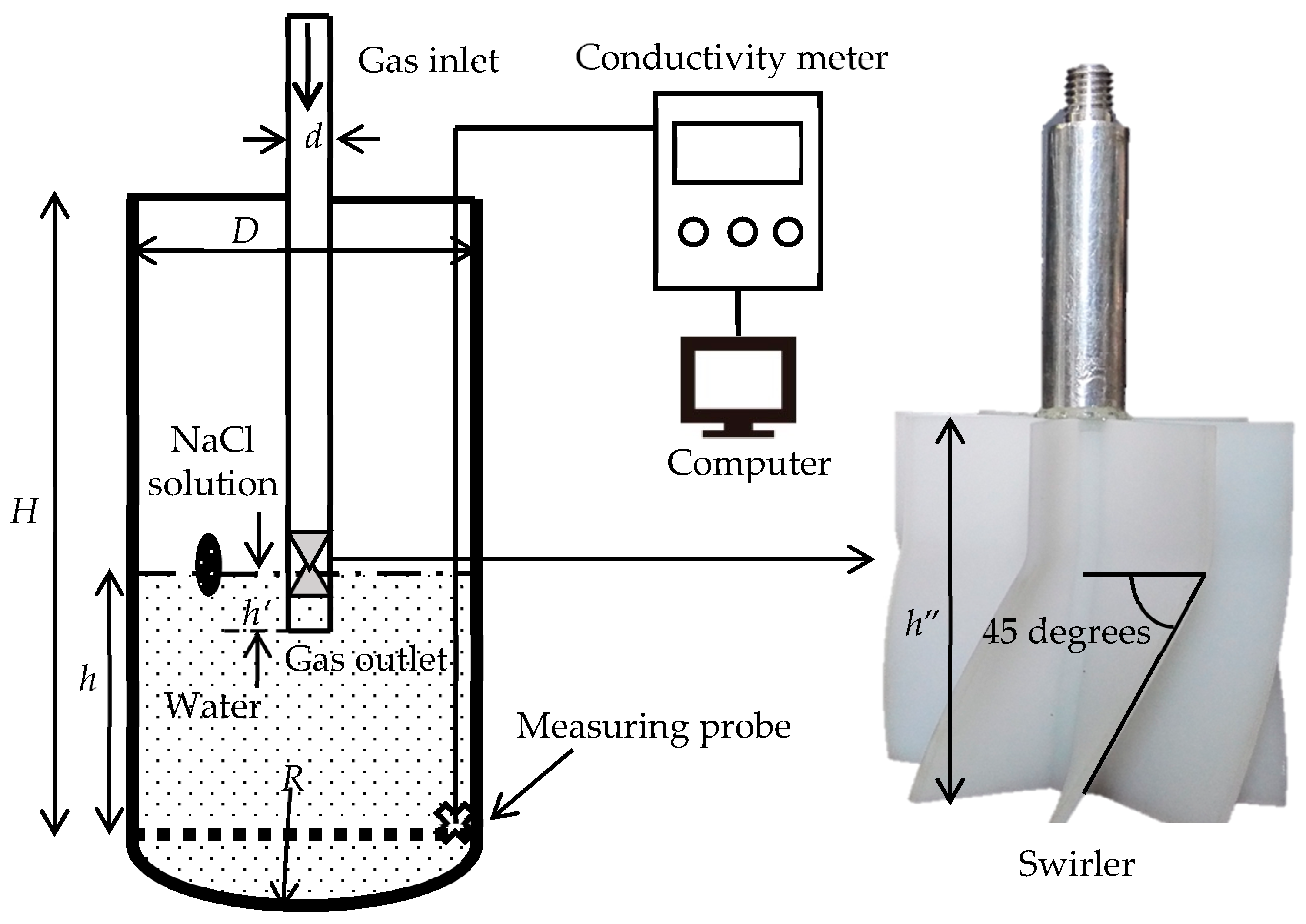
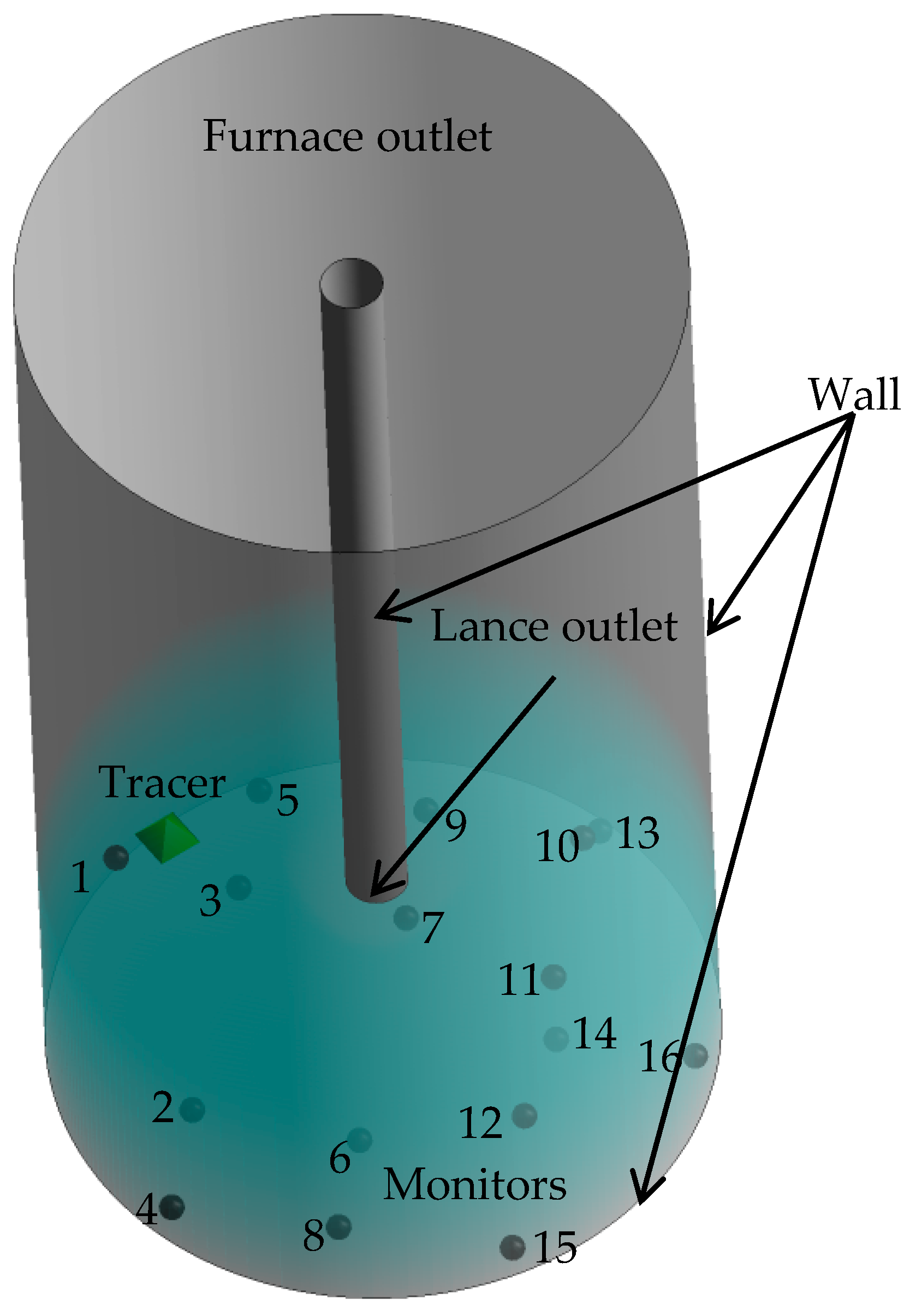
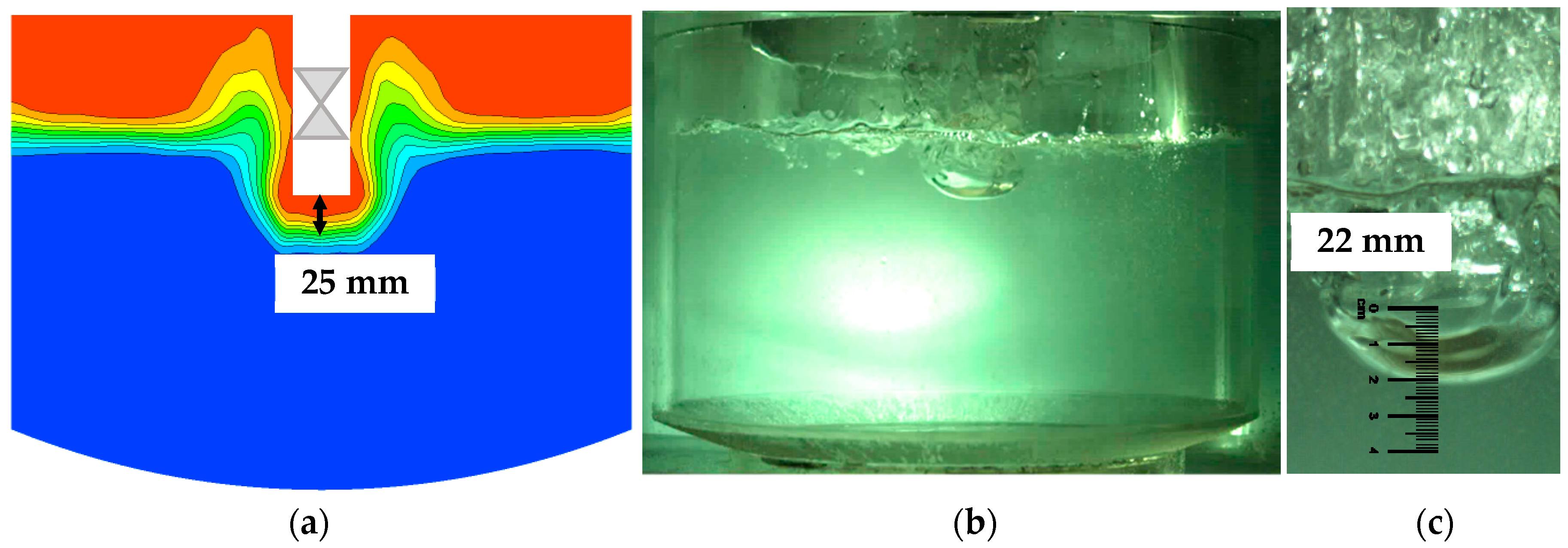
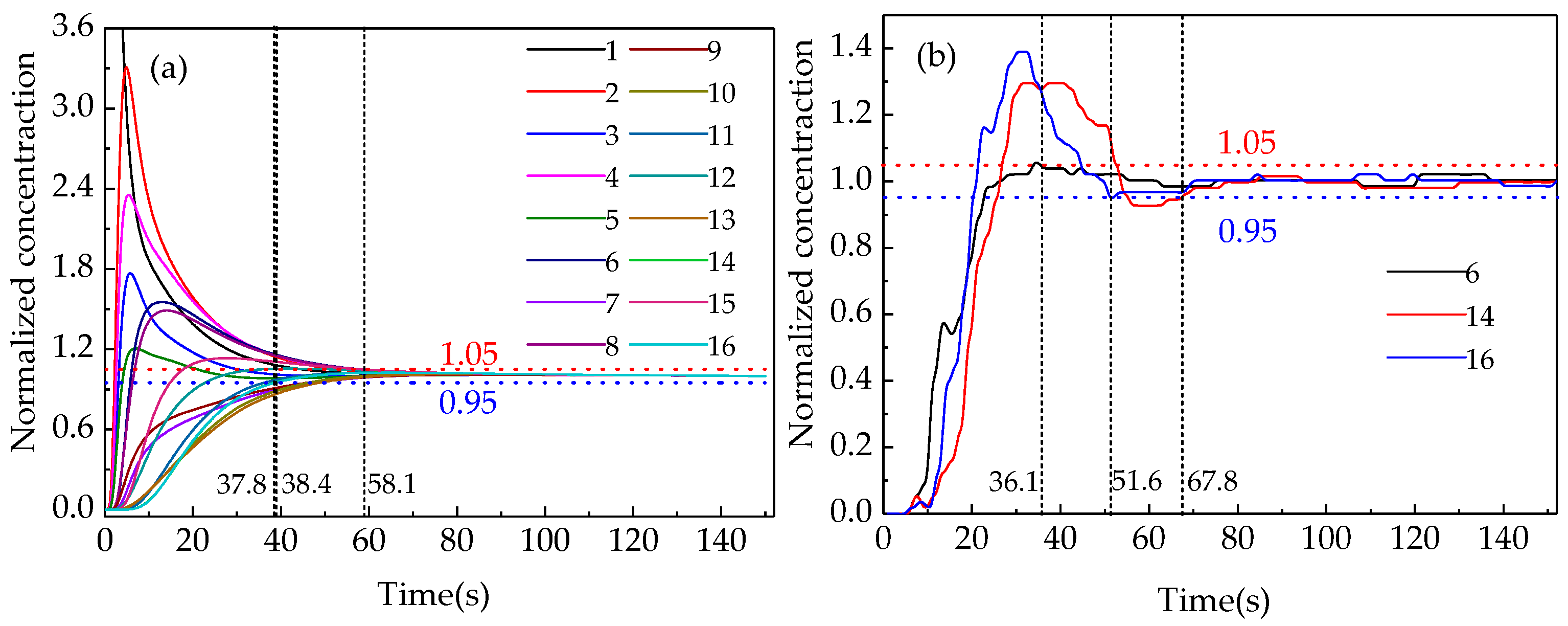
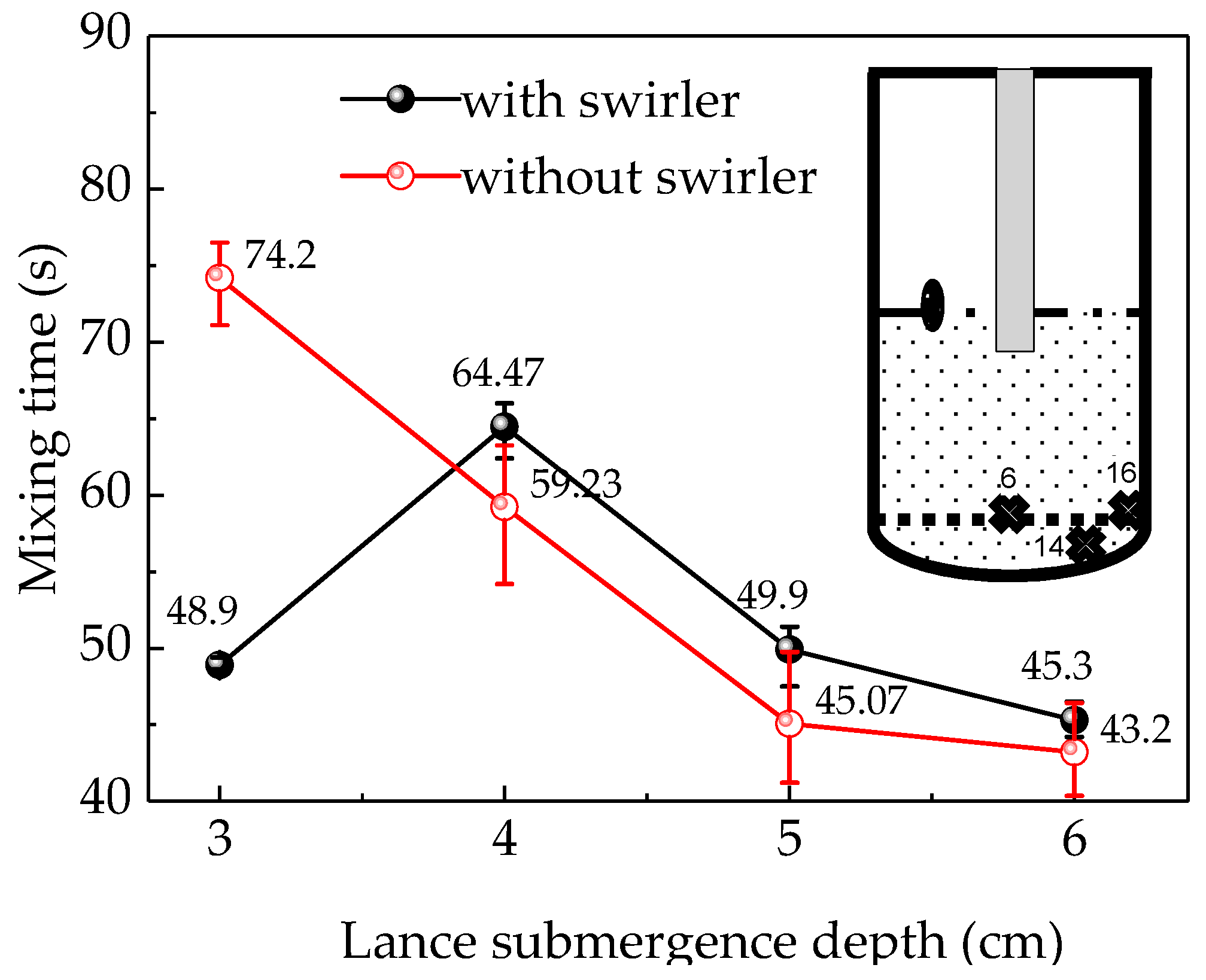
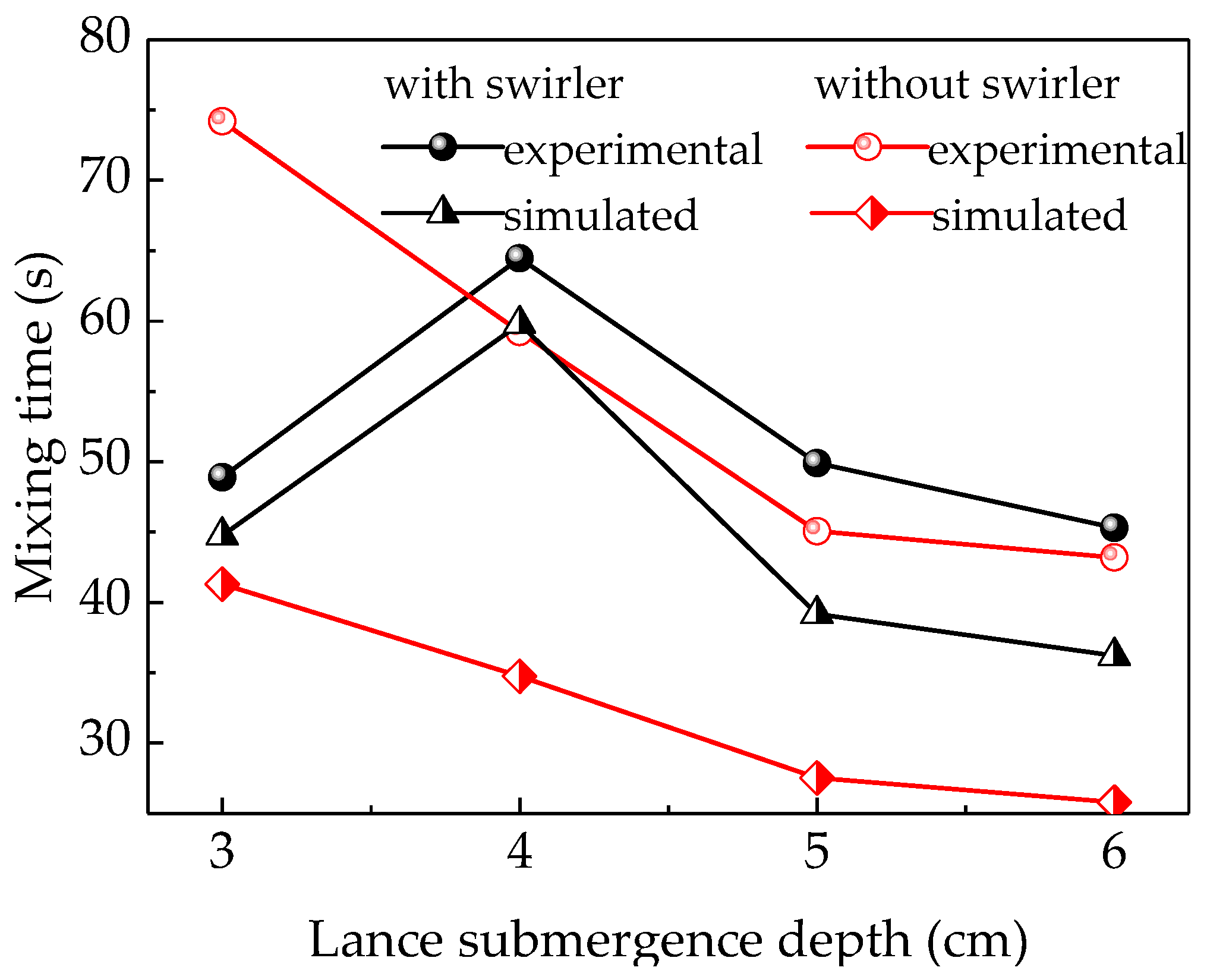
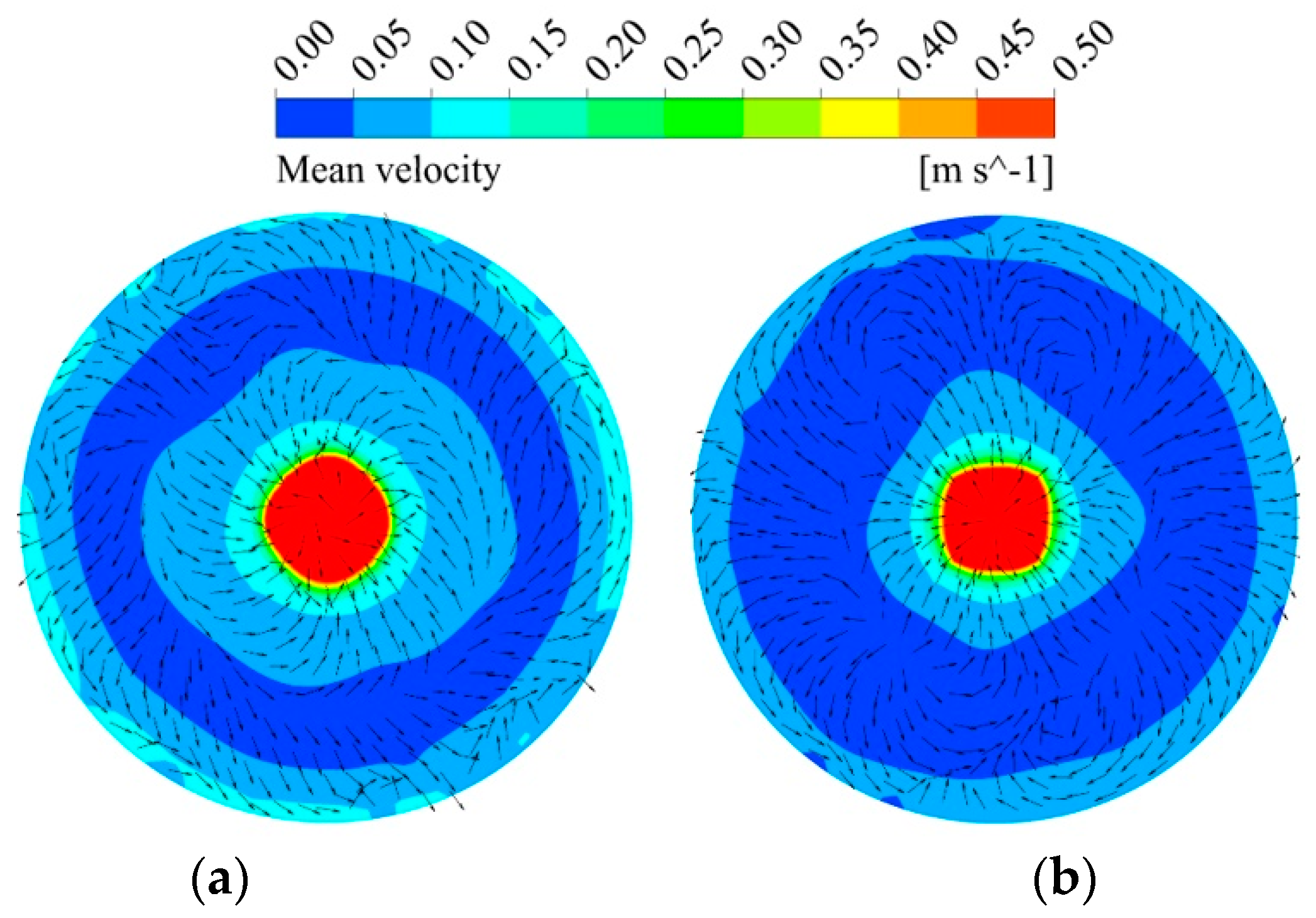

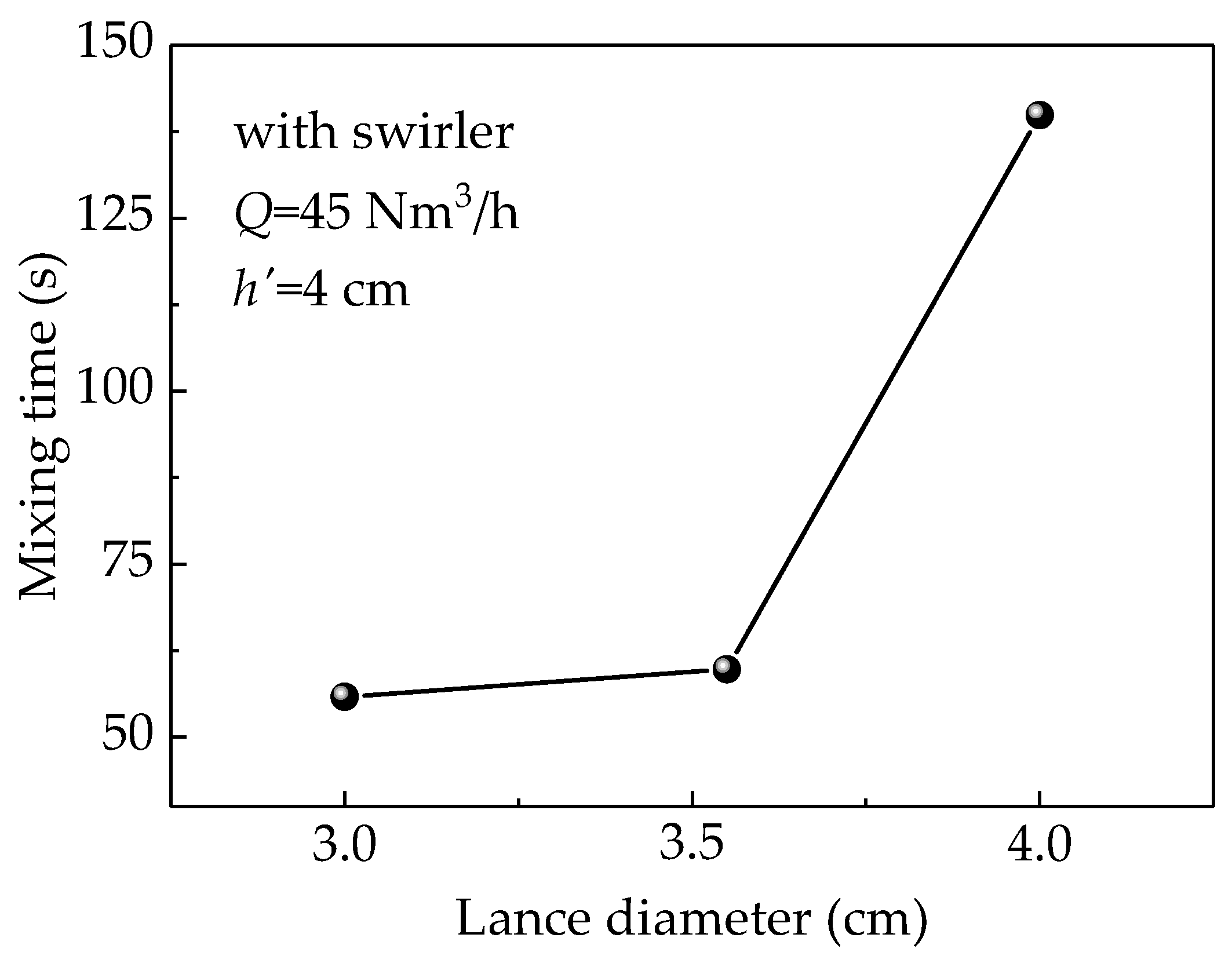
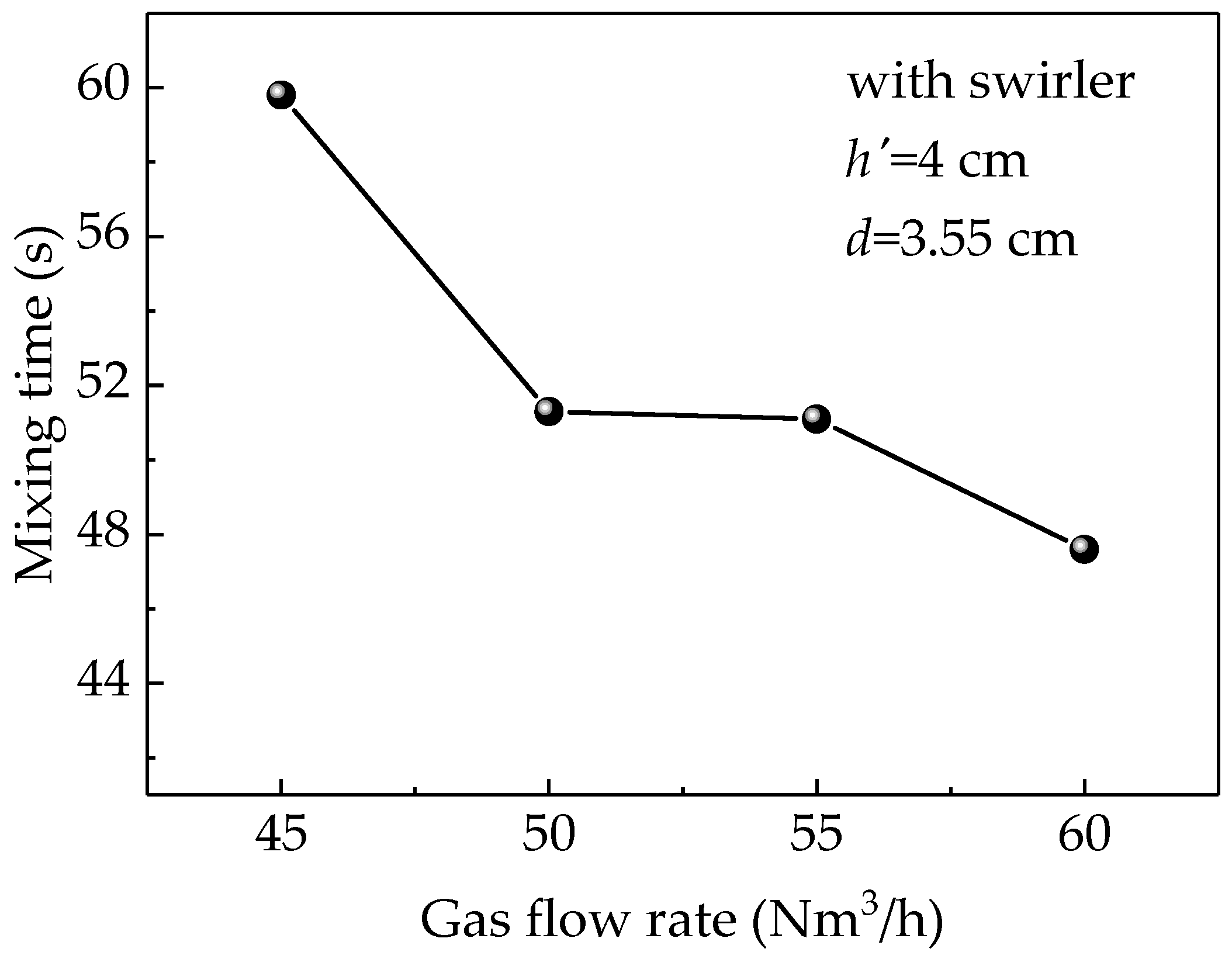
| Parameters | ISASMELT Furnace | Water-Model |
|---|---|---|
| Furnace height H, m | 7.173 | 0.7173 |
| Furnace diameter D, m | 3.84 | 0.384 |
| Furnace bottom radius R, m | 5.00 | 0.5 |
| Lance diameter d, m | 0.303–0.4 | 0.03–0.04 |
| Liquid level h, m | 1.85–2 | 0.185 |
| Lance submergence depth h’, m | 0.3 | 0.03–0.05 |
| Swirler height h’’, m | 0.5 | 0.05 |
| Total gas volume Q, Nm3/h | 30,000–32,000 | 45–60 |
| Gas density ρg, kg/m3 | 1.36 | 1.25 |
| Liquid density ρl, kg/m3 | 4500 (matte), 3500 (slag) | 1000 |
© 2019 by the authors. Licensee MDPI, Basel, Switzerland. This article is an open access article distributed under the terms and conditions of the Creative Commons Attribution (CC BY) license (http://creativecommons.org/licenses/by/4.0/).
Share and Cite
Zhao, H.; Lu, T.; Yin, P.; Mu, L.; Liu, F. An Experimental and Simulated Study on Gas-Liquid Flow and Mixing Behavior in an ISASMELT Furnace. Metals 2019, 9, 565. https://doi.org/10.3390/met9050565
Zhao H, Lu T, Yin P, Mu L, Liu F. An Experimental and Simulated Study on Gas-Liquid Flow and Mixing Behavior in an ISASMELT Furnace. Metals. 2019; 9(5):565. https://doi.org/10.3390/met9050565
Chicago/Turabian StyleZhao, Hongliang, Tingting Lu, Pan Yin, Liangzhao Mu, and Fengqin Liu. 2019. "An Experimental and Simulated Study on Gas-Liquid Flow and Mixing Behavior in an ISASMELT Furnace" Metals 9, no. 5: 565. https://doi.org/10.3390/met9050565





